Microstructure Development and Its Influence on the Properties of Styrene-Ethylene-Butylene-Styrene/Polystyrene Blends
Abstract
:1. Introduction
2. Materials and Methods
2.1. Raw Materials
2.2. Blend Sample Preparation and Torque Measurements
2.3. Morphological Studies
2.4. Tensile Test
2.5. Thermal Characterization
2.6. Melt State Dynamic Rheological Studies
2.7. Shear Rheology
3. Results and Discussion
3.1. Morphological Studies
3.2. Mechanical Properties
3.3. Thermal Characterization
3.4. Dynamic Rheology
3.5. Shear Rheology
4. Energy Requirements for Processing
5. Conclusions
- When SEBS is blended with PS, a portion of the added PS increases the domain size of the copolymer, while the remaining portion phase separates. Blends of higher PS content show a fibrillar microstructure.
- An increase in PS content results in a remarkable increase in tensile modulus and an unexpected rise in Tg of the PS phase, attributed to the fibrillar microstructure in which the fibrils have a strong interaction with SEBS.
- All blends show two modes of relaxation corresponding to the PS phase and the elastomeric phase. The long relaxation time of the elastomeric phase indicates the tendency of these blends to undergo time-dependent shrinkage in secondary processing operations.
- An increase in PS content of the blends results in lower values of viscosity and energy requirement for mixing, indicating easier flow and more sustainable processing. The blends with a fibrillar microstructure have lower than expected values of viscosity attributed to additional slippage provided by the aligned low viscosity fibrils to the elastomeric chains.
Acknowledgments
Author Contributions
Conflicts of Interest
References
- Legge, N.R.; Holden, G.; Shroeder, H.E. Thermoplastic Elastomer: A Comprehensive Review; Hanser: Munich, Germany, 1987. [Google Scholar]
- Cloitre, M.; Vlassopoulos, D. Block Copolymers in External Fields: Rheology, Flow-Induced Phenomena and Applications. In Applied Polymer Rheology: Polymeric Fluids with Industrial Applications; Kontopoulou, M., Ed.; John Wiley & Sons: Hoboken, NJ, USA, 2012. [Google Scholar]
- Raha, S.; Kao, N.; Bhattacharya, S.N. Modification of styrene-ethylene/butylene-styrene copolymer microstructure by polystyrene homopolymer and evolution of a cocontinuous blend morphology. Polym. Eng. Sci. 2012, 52, 2559–2572. [Google Scholar] [CrossRef]
- Picchioni, F.; Aglietto, M.; Passaglia, E.; Ciardelli, F. Blends of syndiotactic polystyrene with SEBS triblock copolymers. Polymer 2002, 43, 3323–3329. [Google Scholar] [CrossRef]
- Veenstra, H.; Van Dam, J.; Posthuma de Boer, A. On the coarsening of co-continuous morphologies in polymer blends: Effect of interfacial tension, viscosity and physical cross-links. Polymer 2000, 41, 3037–3045. [Google Scholar] [CrossRef]
- Willemse, R.C.; Posthuma de Boer, A.; van Dam, J.; Gotsis, A.D. Co-continuous morphologies in polymer blends: A new model. Polymer 1998, 39, 5879–5887. [Google Scholar] [CrossRef]
- Shields, R.J.; Bhattacharyya, D.; Fakirov, S. Fibrillar polymer-polymer composites: Morphology, properties and applications. J. Mater. Sci. 2008, 43, 6758–6770. [Google Scholar] [CrossRef]
- Maani, A.; Naguib, H.E.; Heuzey, M.-C.; Carreau, P.J. Foaming behaviour of microcellular thermoplastic olefin blends. J. Cell. Plast. 2013, 49, 223–244. [Google Scholar] [CrossRef]
- Banerjee, R.; Ray, S.S.; Ghosh, A.K. Investgations on blending and foaming behavior of styrene-ethylene-butylene-styrene/polystyrene blends. Int. Polym. Process. 2017, 32, 434–445. [Google Scholar]
- Ray, S.S.; Yamada, K.; Okamoto, M.; Ueda, K. New polylactide-layered silicate nanocomposites. 2. Concurrent improvements of material properties, biodegradability and melt rheology. Polymer 2003, 44, 857–866. [Google Scholar]
- Ray, S.S.; Okamoto, K.; Okamoto, M. Structure-property relationship in biodegradable poly(butylene succinate)/layered silicate nanocomposites. Macromolecules 2003, 36, 2355–2367. [Google Scholar]
- Bandyopadhyay, J.; Ray, S.S. The quantitative analysis of nano-clay dispersion in polymer nanocomposites by small angle X-ray scattering combined with electron microscopy. Polymer 2010, 51, 1437–1449. [Google Scholar]
- Yu, R.; Yu, W.; Zhou, C.; Feng, J.J. Rheology and relaxation processes in a melting thermotropic liquid-crystalline polymer. J. Appl. Polym. Sci. 2007, 104, 3780–3787. [Google Scholar] [CrossRef]
- Souza, A.M.C.; Demarquette, N.R. Influence of coalescence and interfacial tension on the morphology of PP/HDPE compatibilized blends. Polymer 2002, 43, 3959–3967. [Google Scholar] [CrossRef]
- Gramespacher, H.; Meissner, J.J. Interfacial tension between polymer melts measured by shear oscillations of their blends. J. Rheol. 1992, 36, 1127. [Google Scholar] [CrossRef]
- Vinckier, I.; Moldenaers, P.; Mewis, J. Relationship between rheology and morphology of model blends in steady shear flow. J. Rheol. 1996, 40, 613. [Google Scholar] [CrossRef]
- Ojijo, V.; Ray, S.S.; Sadiku, R. The role of specific inerfacil area in controlling properties of immiscible blends of biodegradable polylactide and poly[(butylene succinate)-co-adipate]. ACS Appl. Mater. Interfaces 2012, 4, 6690–6701. [Google Scholar] [CrossRef] [PubMed]
- Afshari, M.; Kotek, R.; Haghighat Kish, M.; Nazock Dast, H.; Gupta, B.S. Effect of blend ratio on bulk properties and matrix-fibril morphology of polypropylene/nylon 6 polyblend fibers. Polymer 2002, 43, 1331–1341. [Google Scholar] [CrossRef]
- Vankan, R.; Degee, P.; Jer6me, R.; Teyssie, P. Design of polymer blend rheology III. Effect of maleic anhydride containing copolymers on the melt viscosity of polyamides. Polym. Bull. 1994, 33, 221–228. [Google Scholar] [CrossRef]
- Berger, W.; Kammer, H.W.; Kummerlőwe, C. Melt rheology and morphology of polymer blends. Die Makromol. Chem. 1984, 8, 101–108. [Google Scholar] [CrossRef]
- Park, S.J.; Kim, B.K.; Jeong, H.M. Morphological, thermal and rheological properties of the blends polypropylene/nylon-6, polypropylene/nylon-6/(maleic anhydride-g-polypropylene) and (maleic anhydride-g-polypropylene)/nylon-6. Eur. Polym. J. 1990, 26, 131–136. [Google Scholar] [CrossRef]
- Gu, S.-Y.; Ren, J.; Dong, B. Melt rheology of polylactide/montmorillonite nanocomposites. J. Polym. Sci. B 2007, 45, 3189–3196. [Google Scholar] [CrossRef]
- Kwak, S.-Y.; Ahn, D.U. Processability of Hyperbranched Poly(ether ketone)s with Different Degrees of Branching from Viewpoints of Molecular Mobility and Comparison with Their Linear Analogue. Macromolecules 2000, 33, 7557–7563. [Google Scholar] [CrossRef]
- Malkin, A.I.; Malkin, A.Y.; Isayev, A.I. Rheology: Concepts, Methods & Applications; ChemTec Publishing: Toronto, ON, Canada, 2006. [Google Scholar]
- Joseph, R.; McGregor, W.J.; Martyn, M.T.; Tanner, K.E.; Coates, P.D. Effect of hydroxyapatite morphology/surface area on the rheology and processability of hydroxyapatite filled polyethylene composites. Biomaterials 2002, 23, 4295–4302. [Google Scholar] [CrossRef]
- López Manchado, M.A.; Biagiotti, J.; Kenny, J.M. Rheological behavior and processability of polypropylene blends with rubber ethylene propylene diene terpolymer. J. Appl. Polym. Sci. 2001, 81, 1–10. [Google Scholar] [CrossRef]
- Li, M.; Yang, Q.; Kong, M.; Huang, Y.; Liao, X.; Niu, Y.; Zhao, Z. Role of dicumyl peroxide on the morphology and mechanical performance of polypropylene random copolymer in microinjection molding. Polym. Adv. Technol. 2017. [Google Scholar] [CrossRef]
- Raha, S.; Kao, N.; Bhattacharya, S.N. Effect of polypropylene on the rheology of co-continuous PS/ SEBS blends. Polym. Eng. Sci. 2005, 45, 1432–1444. [Google Scholar] [CrossRef]
- Massey, L.K. Permeability Properties of Plastics and Elastomers: A Guide to Packaging and Barrier Materials; Cambridge University Press: Cambridge, UK, 2003. [Google Scholar]
- Ghosh, S.; Khastgir, D.; Bhowmick, A.K. Phase modification of SEBS block copolymer by different additives and its effect on morphology, mechanical and dynamic mechanical properties. J. Appl. Polym. Sci. 1998, 67, 2015–2025. [Google Scholar] [CrossRef]
- Ganguly, A.; Maiti, M.; Bhowmick, A.K. Structure-property relationship of specialty elastomer-clay nanocomposites. Bull. Mater. Sci. 2008, 31, 455–459. [Google Scholar] [CrossRef]
- Powell, P.C.; Ingen Housz, A.J. Engineering with Polymers; Stanley Thornes: Cheltenham, UK, 1998. [Google Scholar]
- Yousfi, M.; Alix, S.; Lebeau, M.; Soulestin, J.; Lacrampe, M.-F.; Krawczak, P. Evaluation of rheological properties of non-Newtonian fluids in micro rheology compounder: Experimental procedures for a reliable polymer melt viscosity measurement. Polym. Test. 2014, 40, 207–217. [Google Scholar] [CrossRef]
- Gamon, G.; Evon, P.; Rigal, L. Twin-screw extrusion impact on natural fibre morphology and material properties in poly(lactic acid) based biocomposites. Ind. Crop. Prod. 2013, 46, 173–185. [Google Scholar] [CrossRef] [Green Version]
- Leroy, E.; Jacquet, P.; Coativy, G.; Reguerre, A.L.; Lourdin, D. Compatibilization of starch-zein melt processed blends by an ionic liquid used as plasticizer. Carbohydr. Polym. 2012, 89, 955–963. [Google Scholar] [CrossRef] [PubMed]
- Bialleck, S.; Rein, H. Preparation of starch-based pellets by hot-melt extrusion. Eur. J. Pharm. Biopharm. 2011, 79, 440–448. [Google Scholar] [CrossRef] [PubMed]
- Sharudin, R.; Ohshima, M. Preparation of microcellular thermoplastic elastomer foams from polystyrene-b-ethylene-butylene-b-polystyrene (SEBS) and their blends with polystyrene. J. Appl. Polym. Sci. 2013, 128, 2245–2254. [Google Scholar] [CrossRef]
- Banerjee, R.; Ray, S.S.; Ghosh, A.K. Dynamic rheology and foaming behaviour of styrene-ethylene-butylene-styrene/polystyrene blends. J. Cell. Plast. 2017, 53, 389–406. [Google Scholar] [CrossRef]
- Takayanagi, M.; Harima, H.; Iwata, Y. Viscoelastic behaviour of polymer blends and its comparison with model experiments. Mem. Fac. Eng. Kyushu Univ. 1963, 23, 1–13. [Google Scholar]
- Manson, J.A.; Sperling, L.H. Polymer Blends and Composites; Plenum Press: New York, NY, USA, 1976. [Google Scholar]
- Veenstra, H.; Verkooijen, P.C.; van Lent, B.J.; van Dam, J.; de Boer, A.P.; Nijhof, A.P. On the mechanical properties of co-continuous polymer blends: Experimental and modelling. Polymer 2000, 41, 1817–1826. [Google Scholar] [CrossRef]
- Davies, W.E.A. The theory of elastic composite materials. J. Phys. D Appl. Phys. 1971, 4, 313. [Google Scholar] [CrossRef]
- Kalaprasad, G.; Joseph, K.; Thomas, S. Theoretical modelling of tensile properties of short sisal fibre-reinforced low-density polyethylene composites. J. Mater. Sci. 1997, 32, 4261–4267. [Google Scholar] [CrossRef]
- Xiong, J.; Mashiur, R. Mechanical property measurement and prediction using Hirsch’s model for glass yarn reinforced polyethylene composite fabric formwork. J. Text. Sci. Eng. 2016, 6, 241–250. [Google Scholar] [CrossRef]
- Whelan, A.; Lee, K.S. Developments in Rubber Technology—2: Synthetic Rubbers; Springer: Dordrecht, The Netherlands, 1981. [Google Scholar]
- Gedde, U.W. Polymer Physics; Chapman & Hall: London, UK, 1995. [Google Scholar]
- Utracki, L.A. Thermodynamics of Polymer Blends. In Polymer Blends Handbook Volume 1; Kluwer Academic Publishers: Dordrecht, The Netherlands, 1999. [Google Scholar]
- Rodriguez-Parada, J.M.; Percec, V. Interchain EDA complexes: A model for LCST? J. Polym. Sci. Part A 1986, 24, 579–587. [Google Scholar] [CrossRef]
- Liu, M.H.; Li, R.; Wang, G.; Hou, Z.Y.; Huang, B. Morphology and dynamic mechanical properties of long glass fiber-reinforced polyamide 6 composites. J. Therm. Anal. Calorim. 2016, 126, 1281–1288. [Google Scholar] [CrossRef]
- Dealy, J.M.; Wissbrun, K.F. Melt Rheology and Its Role in Plastics Processing; Van Nostrand Reinhold: New York, NY, USA, 1990. [Google Scholar]
- Elias, L.; Fenouillot, F.; Majested, J.C.; Cassagnauab, P. Morphology and rheology of immiscible polymer blends filled with silica nanoparticles. Polymer 2007, 48, 6029–6040. [Google Scholar] [CrossRef]
- Smith, T.L.; Dickie, R.A. Viscoelastic and ultimate tensile properties of styrene-butadiene-styrene block copolymers. J. Polym. Sci. Part C 1969, 26, 163–187. [Google Scholar] [CrossRef]
- Takahashi, T.; Takimoto, J.-I.; Koyama, K. Elongational viscosities of random and block copolymer melts. J. Appl. Polym. Sci. 1998, 69, 1765–1774. [Google Scholar] [CrossRef]
- Honerkamp, J.; Weese, J. Tikhonovs regularization method for ill-posed problems. Contin. Mech. Thermodyn. 1990, 2, 17–30. [Google Scholar] [CrossRef]
- Honerkamp, J.; Weese, J. A nonlinear regularization method for the calculation of relaxation spectra. Rheol. Acta 1993, 32, 65–73. [Google Scholar] [CrossRef]
- Barnes, H.A. A review of the slip (wall depletion) of polymer solutions, emulsions and particle suspensions in viscometers: Its cause, character, and cure. J. Nonnewton. Fluid Mech. 1995, 56, 221–251. [Google Scholar] [CrossRef]
- Walter, B.L.; Pelteret, J.-P.; Kaschta, J.; Schubert, D.W.; Paul, S. On the wall slip phenomenon of elastomers in oscillatory shear measurements using parallel-plate rotational rheometry: I. Detecting wall slip. Polym. Test. 2017, 61, 430–440. [Google Scholar] [CrossRef]
- Brydson, J.A. Flow Properties of Polymer Melts; Godwin in association with the Plastics and Rubber Institute: London, UK, 1981. [Google Scholar]
- Kim, S.G.; Leung, S.N.; Park, C.B.; Sain, M. The effect of dispersed elastomer particle size on heterogeneous nucleation of TPO with N2 foaming. Chem. Eng. Sci. 2011, 66, 3675–3686. [Google Scholar] [CrossRef]
- Hsieh, T.-T.; Tiu, C.; Simon, G. Properties of Thermotropic Liquid Crystalline Polymer Blends. In Polymer Blends and Alloys; Shonaike, G.O., Simon, G.P., Eds.; Marcel Dekker: New York, NY, USA, 1999. [Google Scholar]
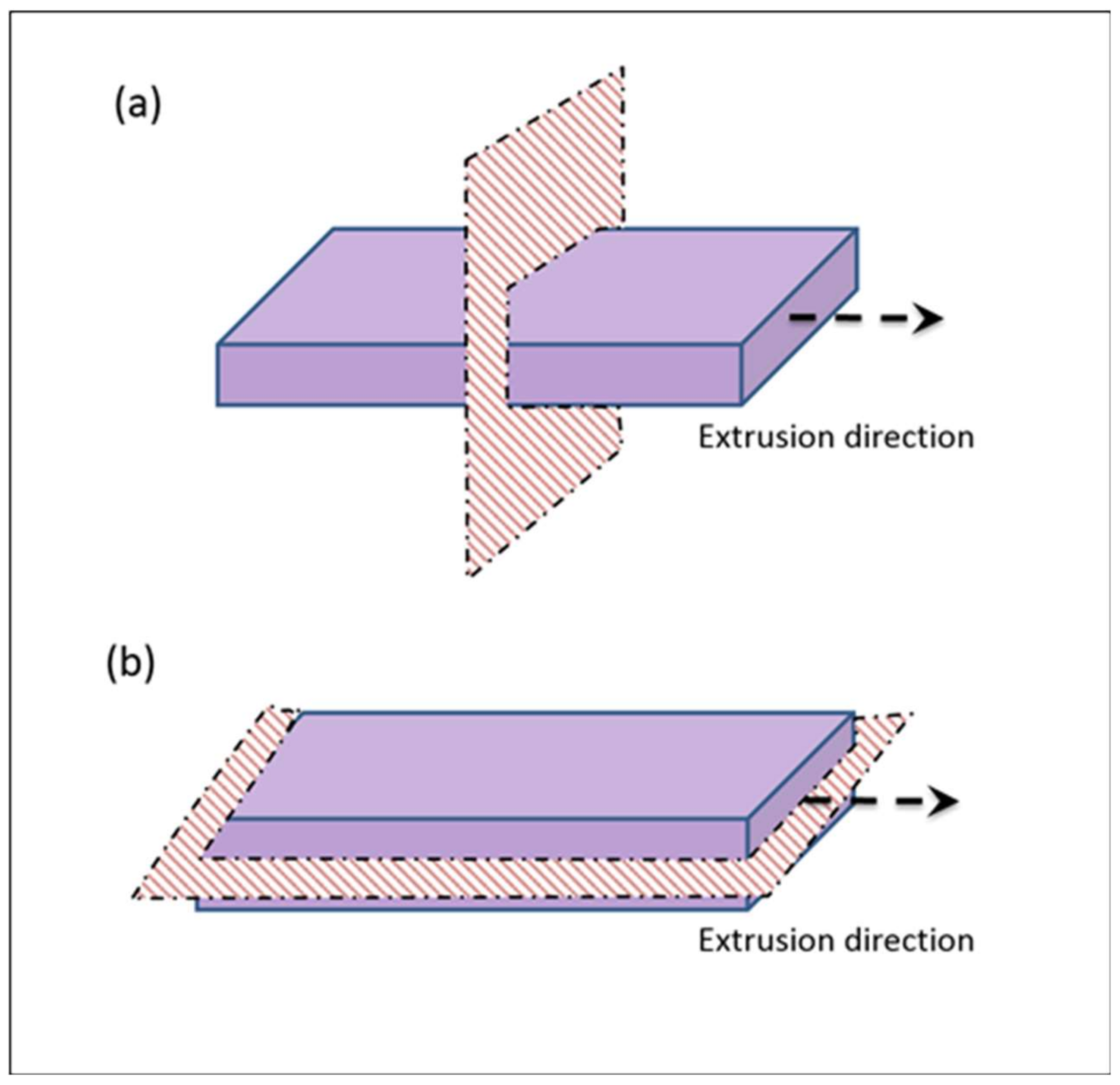
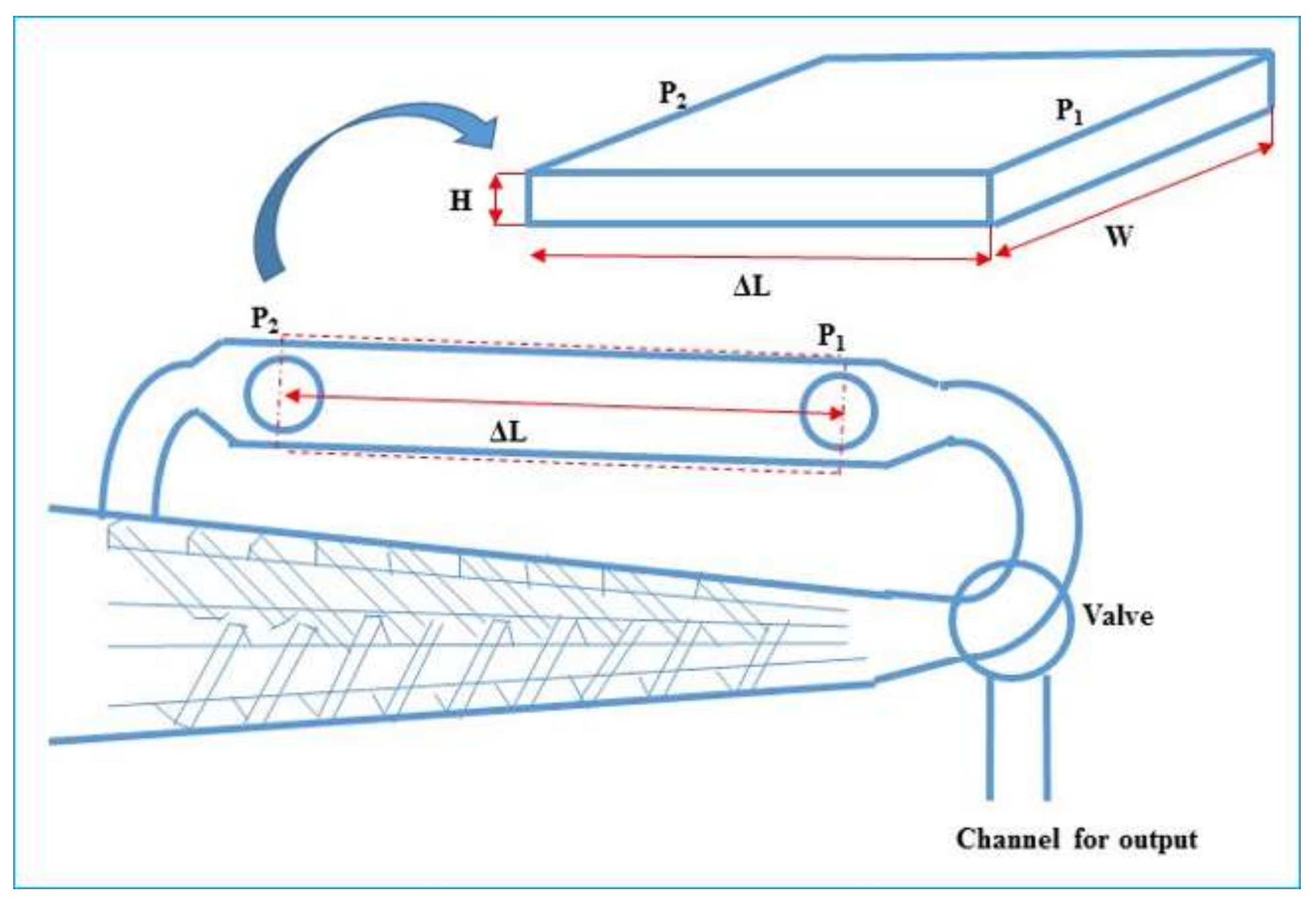
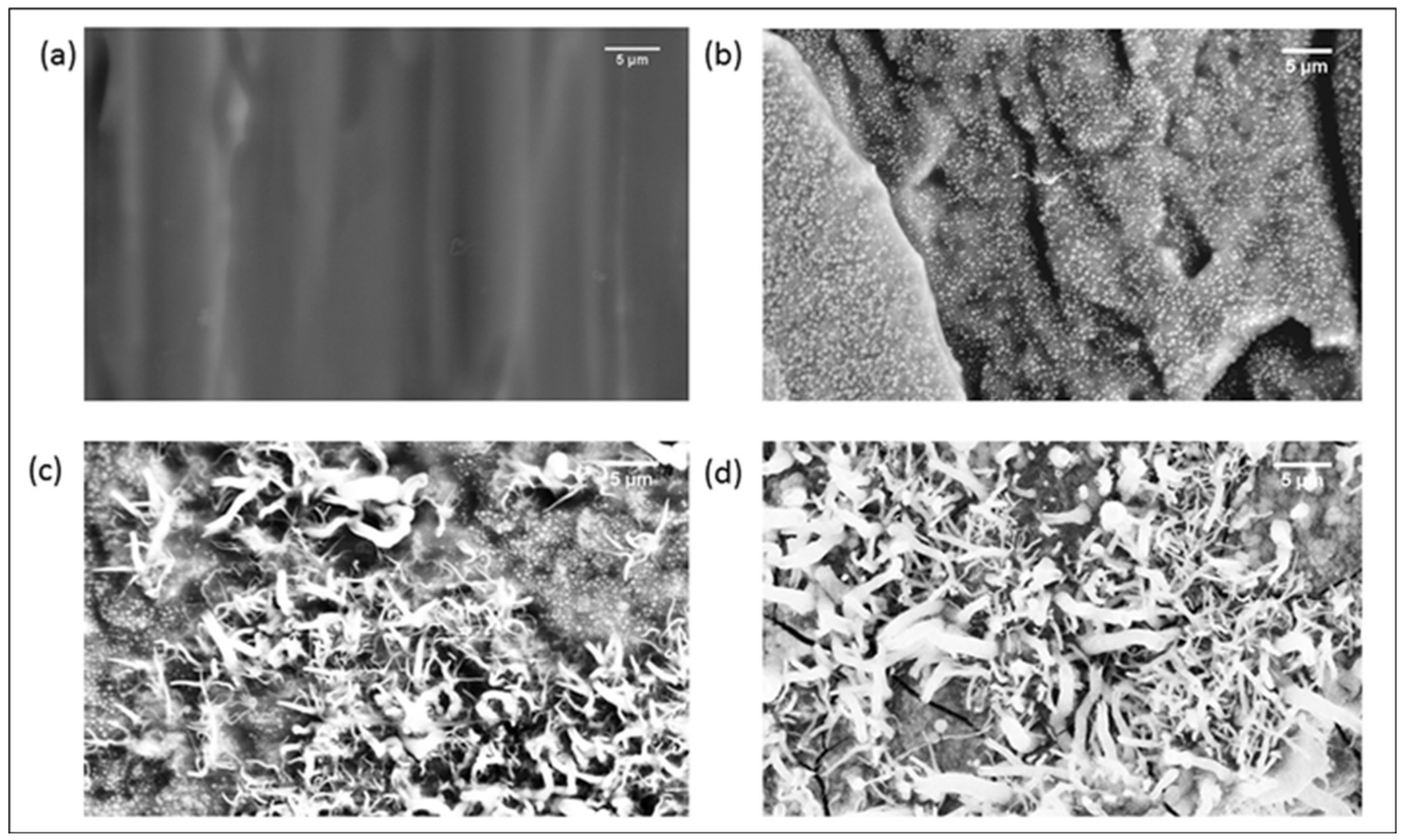

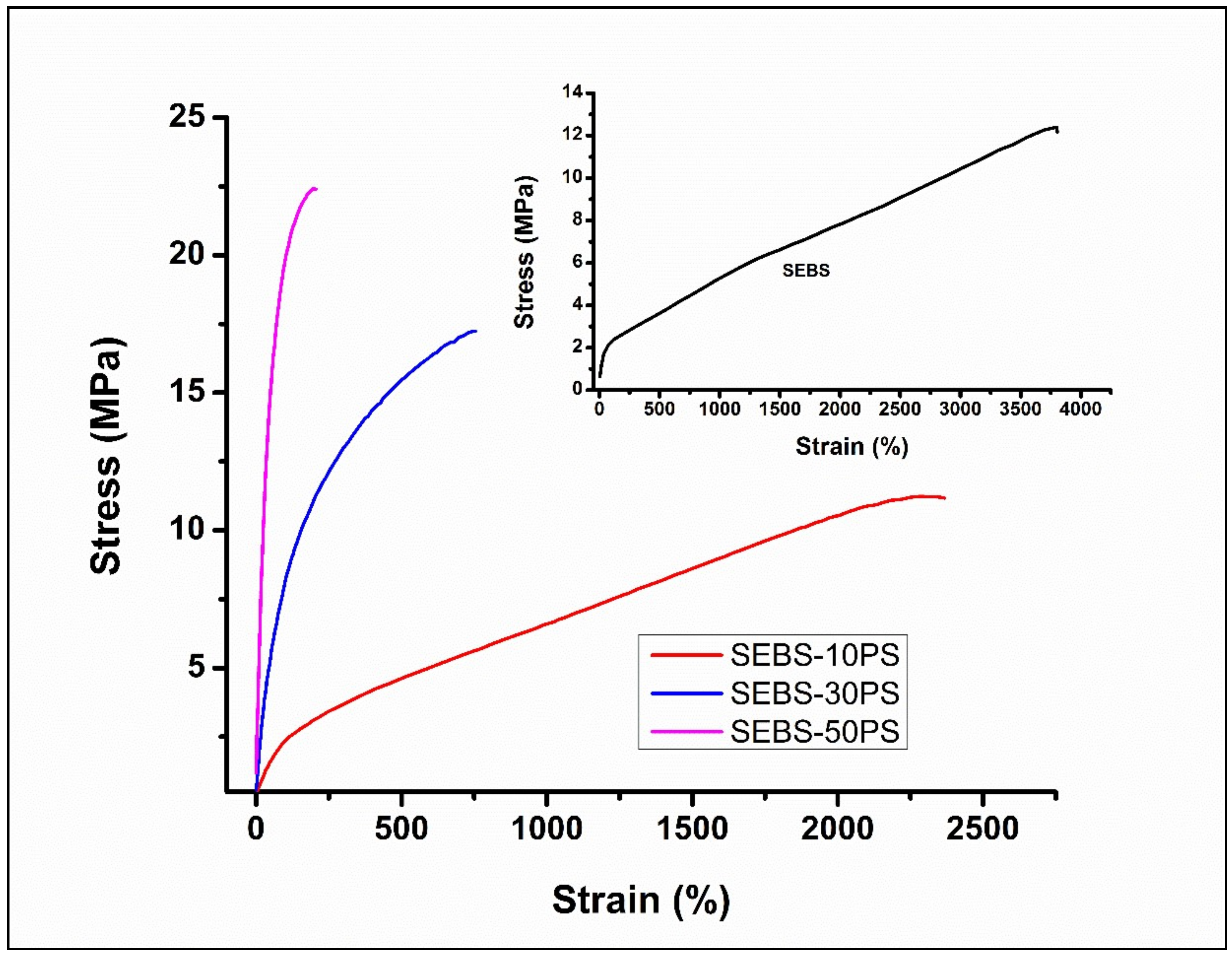
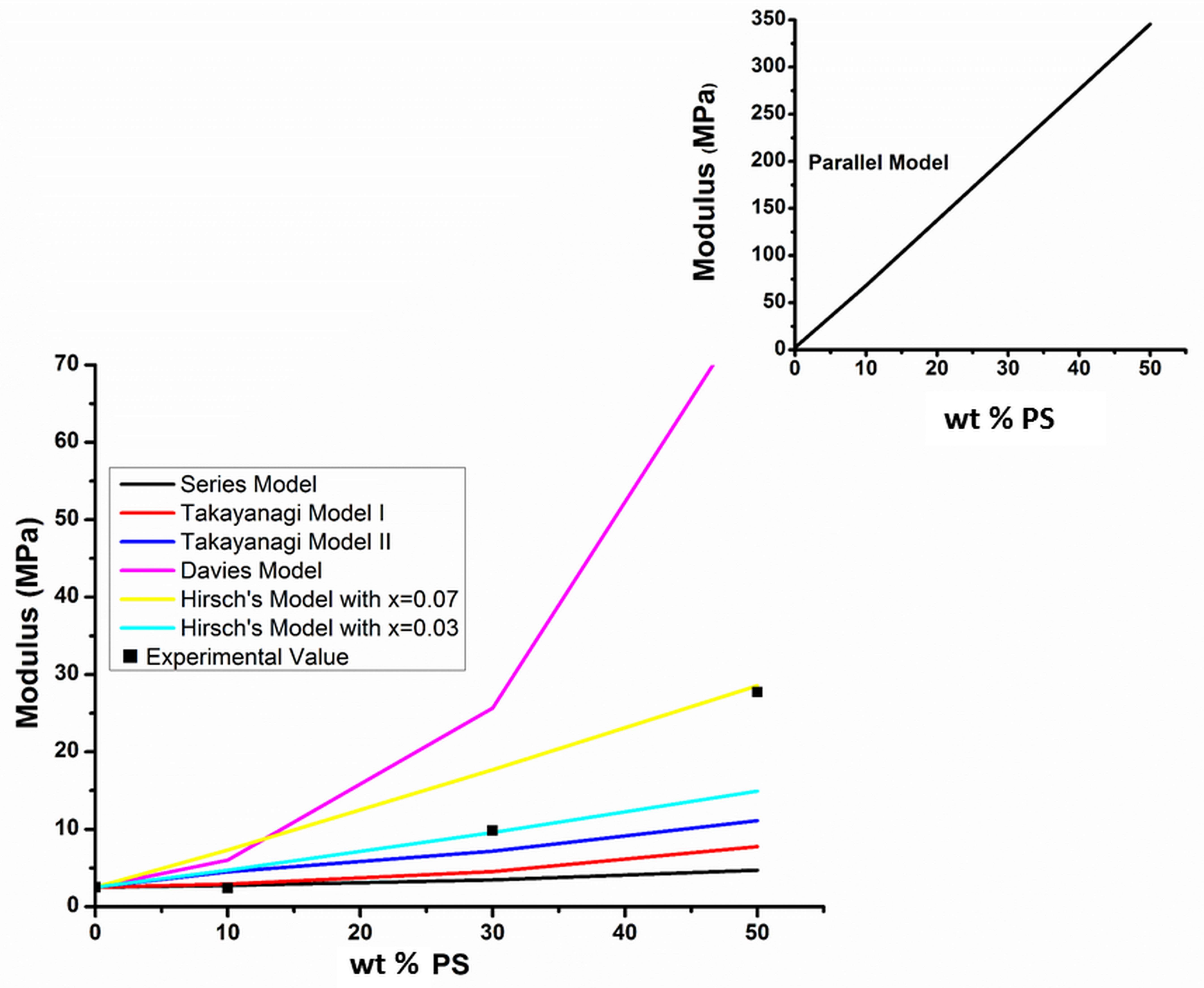
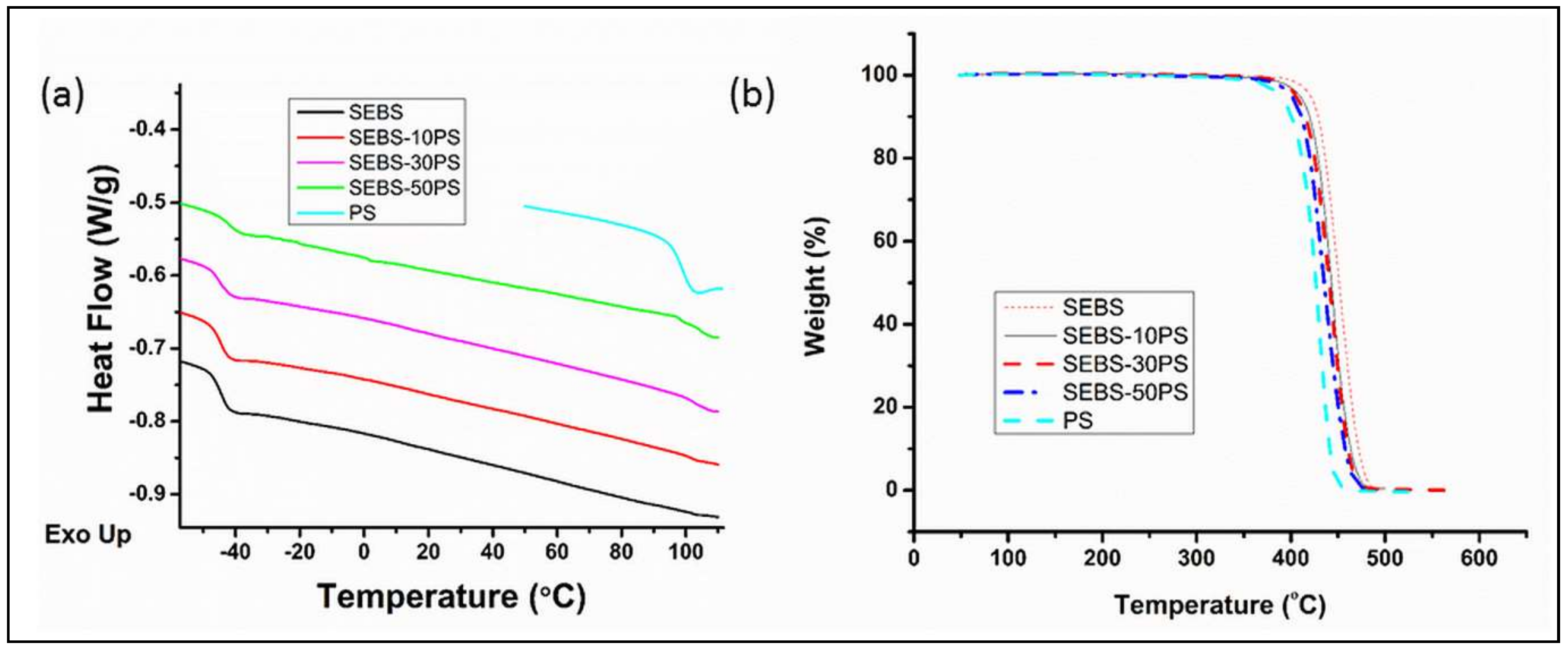
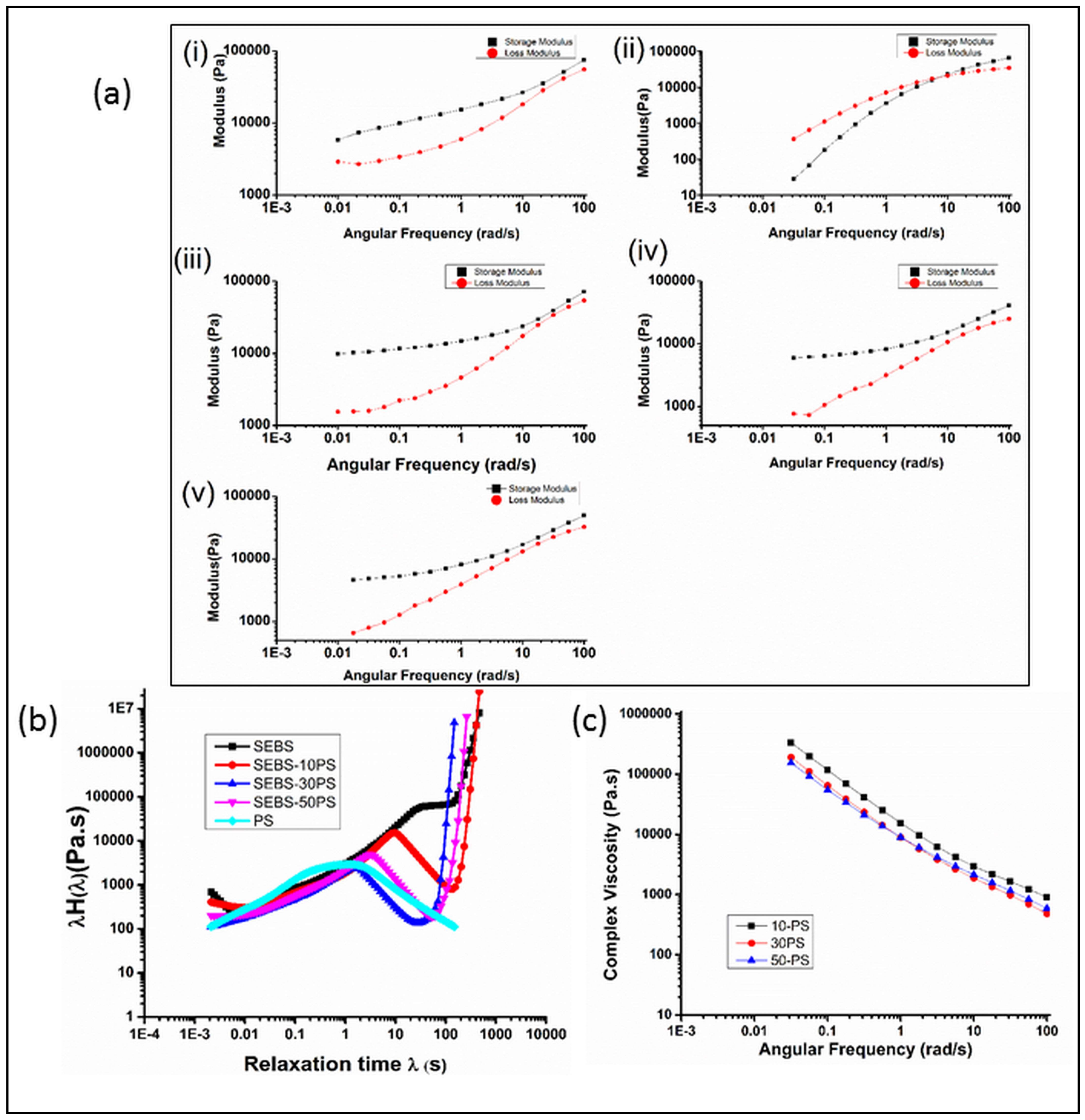
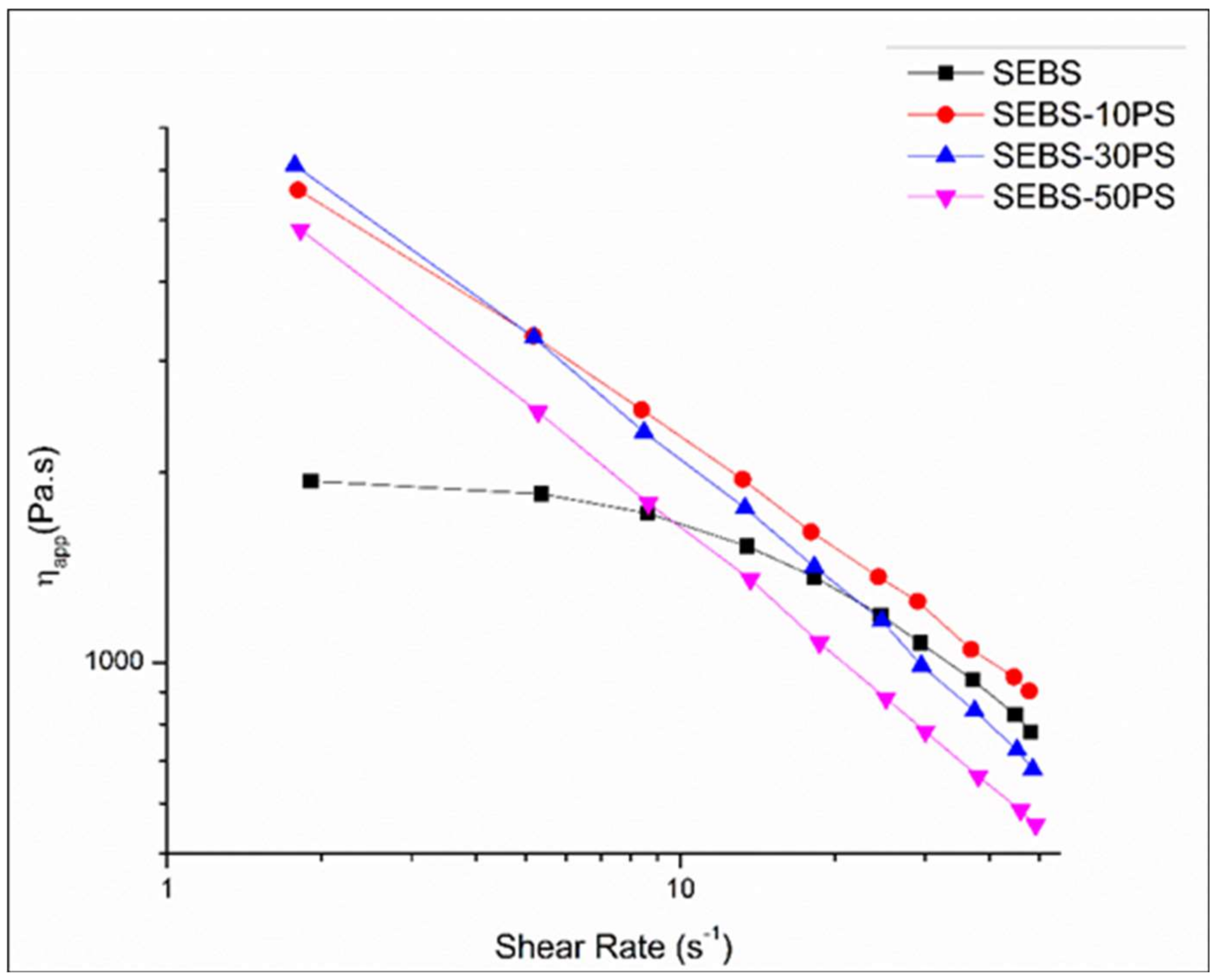
| Composition | wt % of SEBS | wt % of PS | E20 (MPa) | UTS (MPa) | EAB (%) | Toughness (MJ/m3) |
|---|---|---|---|---|---|---|
| SEBS | 100 | 0 | 2.52 ± 0.35 | 11.18 ± 1.1 | 3435.24 ± 300.69 | 282.70 ± 3.82 |
| SEBS-10PS | 90 | 10 | 2.38 ± 0.32 | 11.85 ± 0.71 | 2185.23 ± 188.94 | 170.40 ± 2.56 |
| SEBS-30PS | 70 | 30 | 9.80 ± 0.62 | 15.64 ± 1.97 | 685.4 ± 61.91 | 97.22 ± 6.54 |
| SEBS-50PS | 50 | 50 | 27.71 ± 1.52 | 21.62 ± 0.56 | 182.46 ± 22.99 | 4.74 ± 0.88 |
| Composition | Glass transition temperature(s) (°C) | |||
|---|---|---|---|---|
| Tg of EB Phase | Tg of PS Phase | |||
| DSC Studies | Loss modulus peak | DSC Studies | Loss modulus peak | |
| SEBS | −44 | −29 | 102 | 93 |
| PS | NA | NA | 99 | 106 |
| SEBS-10PS | −45 | −29 | 102 | 97 |
| SEBS-30PS | −45 | −28 | 102 | 116 |
| SEBS-50PS | −42 | −26 | 104 | 112 |
| Composition | Tonset (°C) | T25 (°C) | T50 (°C) |
|---|---|---|---|
| SEBS | 429 | 439 | 451 |
| PS | 410 | 415 | 427 |
| SEBS-10PS | 423 | 431 | 443 |
| SEBS-30PS | 417 | 427 | 440 |
| SEBS-50PS | 413 | 423 | 435 |
| Composition | K (Pa·sn) | n | η50 (Pa·s) | Δη50 (Pa·s) | Ts (Nm) |
|---|---|---|---|---|---|
| SEBS | 6347 | 0.47 | 777.11 | NA | 0.54 |
| SEBS-10PS | 8159 | 0.43 | 902.74 | 135.13 | 0.42 |
| SEBS-30PS | 9648 | 0.33 | 679.10 | −69.50 | 0.36 |
| SEBS-50PS | 7527 | 0.34 | 554.76 | −174.83 | 0.29 |
| PS | 13,134 | 0.24 | 682.07 | NA | 0.52 |
© 2018 by the authors. Licensee MDPI, Basel, Switzerland. This article is an open access article distributed under the terms and conditions of the Creative Commons Attribution (CC BY) license (http://creativecommons.org/licenses/by/4.0/).
Share and Cite
Banerjee, R.; Ray, S.S.; Ghosh, A.K. Microstructure Development and Its Influence on the Properties of Styrene-Ethylene-Butylene-Styrene/Polystyrene Blends. Polymers 2018, 10, 400. https://doi.org/10.3390/polym10040400
Banerjee R, Ray SS, Ghosh AK. Microstructure Development and Its Influence on the Properties of Styrene-Ethylene-Butylene-Styrene/Polystyrene Blends. Polymers. 2018; 10(4):400. https://doi.org/10.3390/polym10040400
Chicago/Turabian StyleBanerjee, Ritima, Suprakas Sinha Ray, and Anup K. Ghosh. 2018. "Microstructure Development and Its Influence on the Properties of Styrene-Ethylene-Butylene-Styrene/Polystyrene Blends" Polymers 10, no. 4: 400. https://doi.org/10.3390/polym10040400







